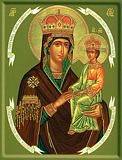

| Previous day | Next day |
| Old Style
March 7
|
Monday |
New Style
March 20
|
|
4th Week of Great Lent.
Tone 7.
Great Lent. |
Monastic rule: xerophagy (bread, uncooked fruits and vegetables).
|
![]() The Holy Hieromartyrs of Chersonese: Basil, Ephraim, Capiton, Eugene, Aetherius, Elpidius, and Agathadorus (4th c.).
The Holy Hieromartyrs of Chersonese: Basil, Ephraim, Capiton, Eugene, Aetherius, Elpidius, and Agathadorus (4th c.).
St. Paul the Simple, of Egypt (4th c.). St. Paul the Confessor, bishop of Plousias in Bithynia (9th c.). St. Emilian, monk, of Rome (6th c.).
New Hieromartyr Nilus (Tyutyukin), hieromonk of St. Joseph of Volokolamsk Monastery (1938).
Icons of the Most Holy Theotokos “Surety of Sinners” (Moscow) (1848) and “Of Czestochowa.”
Sts. Nestor and Arcadius, bishops of Tremithus (4th c.). St. Ephraim, patriarch of Antioch (546). St. Eosterwine, abbot, of Wearmouth (686). St. Lawrence, founder of the monastery of the Mother of God on Salamis (1707). St. Dandus and All Saints of Thrace. Martyrs Codratus, Saturninus, and Rufinus, of Nicomedia (250-259).
Repose of Schemamonk Sisoes of Valaam (1931).
Thoughts for Each Day of the Year
According to the Daily Church Readings from the Word of God
By St. Theophan the Recluse

Monday (the fourth week of Lent).
The Apostle Paul says that the Israelites, crossing the sea, were baptized in it (I Cor. 10:2).[1] Such a baptism served for them as a division between Egypt and themselves. Peter the Apostle adds: The like figure whereunto even baptism doth also now save us (I Pet. 3:21). Our baptism saves us and serves as a dividing wall between the dark, satanic realm of sin and the world, and the brightness of life in Christ. One who is baptized cuts himself off from all earthly hopes and supports, and lives in this age as if in a desert, not tied to anything. His heart is not on the earth, it is totally in that age. All that is here touches him in passing, so that having a wife he is as though he has none; buying, he is as though possessing nothing. In general, he uses the world, as though he uses it not (cf. I Cor. 7:30).
[1]The
Slavonic for I Pet. 3:21 reads: So in like manner
baptism doth also now save us.
Articles
 Hieromartyr Ephraim of ChersonLater on, Saint Ephraim went to the peoples living along the Danube, where he underwent many tribulations and sorrows. He was beheaded at the start of the persecution. |
 Hieromartyr Aetherius of ChersonSaint Aetherius journeyed to Constantinople to thank the emperor for protecting the Christians. He fell ill and died on the return trip. |
 Hieromartyr Elpidius of ChersonThey endured many hardships for the salvation of human souls. |
 Hieromartyr Agathodorus of ChersonAll three bishops shared the fate of their predecessor: they were stoned to death by the pagans on March 7, 311. |
 St. Emilian of RomeSaint Emilian of Italy (in the world Victorinus) was a Roman by birth, and until he was an old man, he led a sinful life. |






